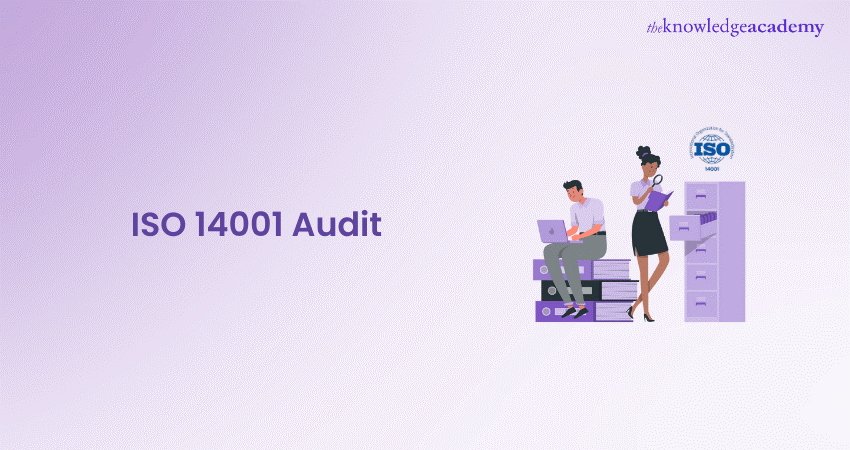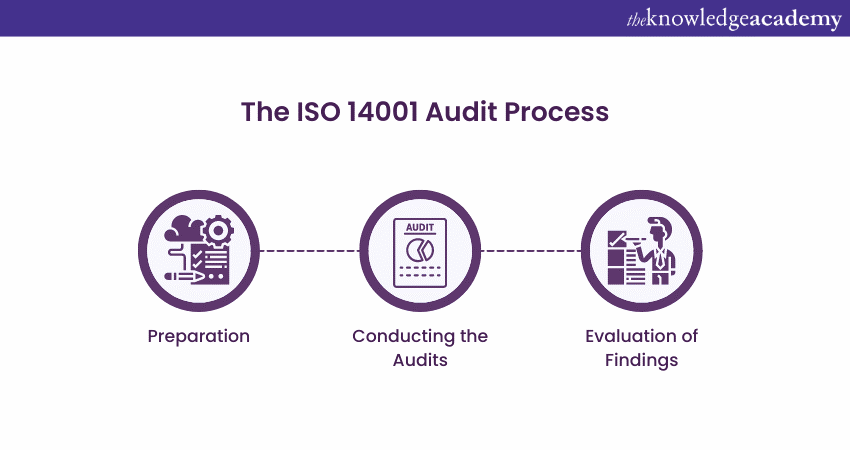We may not have the course you’re looking for. If you enquire or give us a call on +61 272026926 and speak to our training experts, we may still be able to help with your training requirements.
We ensure quality, budget-alignment, and timely delivery by our expert instructors.

Think of an ISO 14001 Audit as a crucial health check-up for your organisation's Environmental Management System. It’s a systematic examination that ensures every practice, policy, and procedure aligns with global environmental standards. Much like a health check-up, an ISO 14001 Audit helps identify areas of strength and points out potential risks. It helps ensure your organisation remains compliant and environmentally responsible.
This audit not only guarantees regulatory compliance but also promotes sustainable practices that can enhance your corporate reputation and operational efficiency. Let’s dive into the essentials of preparing for and succeeding in an ISO 14001 Audit.
Table of Contents
1) Introduction to ISO 14001 Audit
2) What are the Different Types of ISO 14001 Audits?
3) Benefits of Conducting the ISO 14001 Audit
4) The ISO 14001 Audit Process
5) Conclusion
Introduction to ISO 14001 Audit
An ISO 14001 Audit is crucial for implementing the ISO 14001 Environmental Management System (EMS). It involves a systematic, independent, and documented process to gather facts, identify improvement areas, and ensure best practice processes are in place.
This extensive audit includes ISO 14001 Document Control, ensuring compliance with ISO 14001 Software, and considers the ISO 14001 Context of the Organisation. The process also streamlines and enhances the identification and consideration of risks and opportunities in environmental management.
Regular audits of your ISO 14001 Management system will help you:
a) Ensure Compliance with ISO 14001.
b) Verify appropriate actions to meet the ISO standard.
c) Address any issues with the ISO 14001 framework.
d) Identify ways to enhance the standard's implementation.
e) Assess environmental performance and identify areas for improvement.
f) Verify compliance with legal and regulatory Environmental Management requirements.
The ISO 14001 Standard recommends regular internal and external audits, making auditing a key component of our ISO 14001 Certification process.
What are the Different Types of ISO 14001 Audits?
There are two primary types of ISO 14001 Audits: Internal and External. These audits serve distinct purposes in the process of achieving ISO 14001 Certification. Here’s a brief overview on them:
ISO 14001 Internal Audits
Internal Audits are essential for the ISO 14001 Life Cycle, acting as a self-examination of the implemented Environmental Management System (EMS) within the organisation. These audits are crucial for preparing the EMS for External Audits and eventual ISO 14001 Certification.
Their objectives include ensuring conformity with ISO 14001 Standards, evaluating EMS effectiveness, and identifying improvement areas. Internal Audits should follow formal, impartial, and objective processes.
ISO 9001 Auditors often use checklists to record evidence, ensuring consistent audits and assessing the alignment of processes with documented standards. The Audit process involves thoroughly examining task and process execution against established guidelines.
This comparative analysis helps identify areas needing improvement. Observations should be meticulously recorded, and audit results should be reviewed in regular management meetings, held one to four times a year. These meetings enable organisations to make informed decisions and enhancements based on audit findings.
ISO 14001 External Audits
To achieve ISO 14001 Certification, organisations must undergo an External Certification Audit. This audit consists of two main stages. First, the certification body reviews the EMS documentation.
Following this, an on-site audit evaluates various aspects, including the results of Internal Audits, the management review process, and the corrective actions taken in response to the new EMS. Successfully completing this External Audit is essential for obtaining ISO 14001 Certification, demonstrating an organisation's commitment to environmental responsibility, compliance, and effective management of ISO 14001 Risks and Opportunities.
Master Environmental Management with our ISO 14001 Foundation Certification Course - join now!
Benefits of Conducting ISO 14001 Audit
The benefits of conducting an ISO 14001 Audit are numerous and significant for organisations committed to Environmental Management and sustainability. By undergoing this thorough assessment, businesses can unlock various advantages that positively impact their operations, reputation, and overall success. The advantages are explained as follows:
a) Environmental Performance Improvement: An ISO 14001 Audit helps organisations enhance their environmental practices by identifying areas for improvement, such as reducing waste and adopting sustainable processes. This includes maintaining an new to track and manage these improvements.
b) Enhanced Reputation and Credibility: Regular ISO 14001 Audits demonstrate an organisation's commitment to environmental responsibility, thereby enhancing its reputation and credibility among stakeholders.
c) Cost Savings and Increased Efficiency: ISO 14001 Audits uncover opportunities for cost savings and operational efficiency through waste reduction, resource conservation, and streamlined processes, all documented in the Environmental Aspects and Impacts Register.
d) Legal and Regulatory Compliance: By ensuring compliance with environmental laws and regulations, ISO 14001 Audits help organisations avoid legal issues, penalties, and reputational damage.
e) Stakeholder Engagement and Customer Satisfaction: ISO 14001 Certification, obtained through regular audits, showcases an organisation's environmental commitment, leading to increased stakeholder engagement and customer satisfaction.
f) Employee Engagement and Motivation: Involving employees in environmental initiatives through ISO 14001 Audits boosts engagement, motivates them, and gives them a sense of purpose in the workplace, supported by the Environmental Aspects and Impacts Register.
Want to drive sustainable change in your organisation? Sign up for our ISO 14001 Lead Auditor Course now!
The ISO 14001 Audit Process
This section of the blog will elaborate on the stages of the Audit process:

Preparation
Before conducting an ISO 14001 Audit, organisations need to take several preparatory steps. This includes establishing an EMS tailored to their operations, identifying legal and regulatory requirements relevant to their industry, and conducting Internal Audits to assess compliance.
Conducting the Audits
To conduct an ISO 14001 Audit, organisations should select a qualified and independent Auditor who possesses the necessary expertise and experience. The Audit process typically involves document review, site visits, employee interviews, and the reporting of non-conformances.
Evaluation of Findings
Once the ISO 14001 Audit is complete, the Auditor evaluates the findings and assesses the organisation's compliance with the standard. The Auditor identifies any non-conformances and works with the organisation to develop corrective actions. Continual improvement is an essential aspect of the ISO 14001 Audit process.
Conclusion
In conclusion, the ISO 14001 Audit is an essential tool for organisations seeking to manage their environmental impact effectively. It presents a structured approach to Environmental Management, promotes sustainability, and demonstrates a commitment to environmental responsibility. By adhering to the ISO 14001 Standard and conducting regular Audits, organisations can achieve excellence in Environmental Management and gain a competitive advantage.
Enhance your organisation’s Environmental Management practices with our comprehensive ISO 14001 Training. Sign up today!
Frequently Asked Questions
What are the Three Pillars of ISO 14001?

The three pillars of ISO 14001 are Environmental Management System (EMS), continual improvement, and compliance with legal and regulatory requirements. These pillars ensure effective management of environmental responsibilities and promote sustainable practices within organisations.
What should be included in an ISO 14001 Audit Checklist?

An ISO 14001 Audit Checklist should include the following key elements:
1) Environmental Policy
2) Legal and Other Requirements
3) Environmental Objectives and Targets
4) Operational Control
5) Emergency Preparedness and Response
6) Monitoring and Measurement
7) Non-conformity and Corrective Action
What are the Other Resources and Offers Provided by The Knowledge Academy?

The Knowledge Academy takes global learning to new heights, offering over 3,000 online courses across 490+ locations in 190+ countries. This expansive reach ensures accessibility and convenience for learners worldwide.
Alongside our diverse Online Course Catalogue, encompassing 19 major categories, we go the extra mile by providing a plethora of free educational Online Resources like News updates, Blogs, videos, webinars, and interview questions. Tailoring learning experiences further, professionals can maximise value with customisable Course Bundles of TKA.
What is The Knowledge Pass, and How Does it Work?

The Knowledge Academy’s Knowledge Pass, a prepaid voucher, adds another layer of flexibility, allowing course bookings over a 12-month period. Join us on a journey where education knows no bounds.
What are the Related Courses and Blogs Provided by The Knowledge Academy?

The Knowledge Academy offers various ISO 14001 Certifications, including the ISO 14001 Foundation, Lead Auditor and Internal Auditor Courses. These courses cater to different skill levels, providing comprehensive insights into ISO 14001 Risks and Opportunities.
Our Health and Safety Blogs cover a range of topics related to ISO 14001, offering valuable resources, best practices, and industry insights. Whether you are a beginner or looking to advance your Health and Safety skills, The Knowledge Academy's diverse courses and informative blogs have got you covered.
Upcoming Health & Safety Resources Batches & Dates
Date
 ISO 14001 Foundation Certification
ISO 14001 Foundation Certification
Mon 2nd Jun 2025
Mon 11th Aug 2025
Mon 13th Oct 2025
Mon 8th Dec 2025
Mon 19th Jan 2026
Mon 23rd Mar 2026
Mon 11th May 2026
Mon 13th Jul 2026
Mon 21st Sep 2026
Mon 30th Nov 2026






 Top Rated Course
Top Rated Course



 If you wish to make any changes to your course, please
If you wish to make any changes to your course, please


